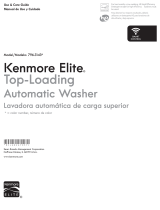
Important safety instructions
General safety
• This washing machine is not intended for
use by persons (including children) with
reduced physical, sensory or mental
capabilities or lack of experience and
knowledge unless they have been given
supervision or instruction concerning the
use of the washing machine by a person
responsible for their safety.
• Children should be supervised to ensure
that they do not play with the washing
machine.
• Never place the washing machine on a
carpeted floor Lack of airflow beneath the
machine could cause overheating.
• In case of a malfunction or maintenance
work, disconnect the washing machine from
the electrical mains immediately. Repairs
must only be made by a qualified technician.
• Before washing, check all clothes for loose
buttons and tears. Check pockets for coins ,
pins or other small articles. Close zips and
fasteners Wash small articles inside a pillow
case.
• Do not wash clothes stained with or soaked
in petrol, thinners, kerosene, vegetable oil or
any other flammable liquids. Nor should any
of these liquids be added to the wash water
as they constitute a fire hazard or there may
be a risk of an explosion.
• Only use the machine for washing fabrics .Do
not attempt to wash plastic leather or
fibreglass. Sort and separate clothes by
fabric, colour and degree of dirt .
• Use detergents, softeners and supplements
suitable for top loading automatic washing
machines only .
• Always unplug the machine from the wall
socket when it requires cleaning or service.
Only permit qualified persons to repair or
install parts in the washer.
• Do not use water which is hotter than 60
degrees Celsius as this may deform
plastic parts of the machine. which could
result in injury, electric shock or water
leakage.
• The water supply and draining hoses must
be securely fastened and remain undamaged
to prevent water leakage.
• Check the water supply hose connection
by turning on the water before washing and
ensure there is no water leakage
• Follow the instructions on the textile tags and
on the detergent package
• Installation and repairing procedures must be
carried out by an Authorized Service Agent .
Repairs carried out by incompetent persons
create a user risk: There may be a risk of
accidental fire If the washer operates
abnormally, it may cause an injury The
Manufacturer shall not be held liable for
damages that may arise from procedures
carried out by unauthorized persons.
• Do not expose the machine to any type of
flame or put cigarettes or any volatile
substances on the machine top. The
machine may catch fire or the machine may
be deformed due to its large number of
plastic components.
• Do not install the machine in a bathroom
or very humid place.
Doing so may cause a malfunction or result
in a short circuit and there is a risk of an
electric shock.
• Never wash the machine by spreading or
pouring water onto it! Avoid spraying water
on to the control panel and back of the
machine. There is the risk of an electric
shock, and it may cause the machine to
malfunction.
Warning! Never reach into or put
your hands into the wash/spin tub
whilst the machine is operating.
If you reach into the wash/spin
tub serious injury could result.
Wait until all motion stops.
Warning! If the wash/spin tub does
not stop within 15 seconds after
the washer lid is opened, switch
off the washer immediately and
call an authorised service person.
Warning! The machine must be
unplugged during installation,
maintenance, cleaning and
repairing procedures to avoid the
risk of an electric shock.
page 4





















